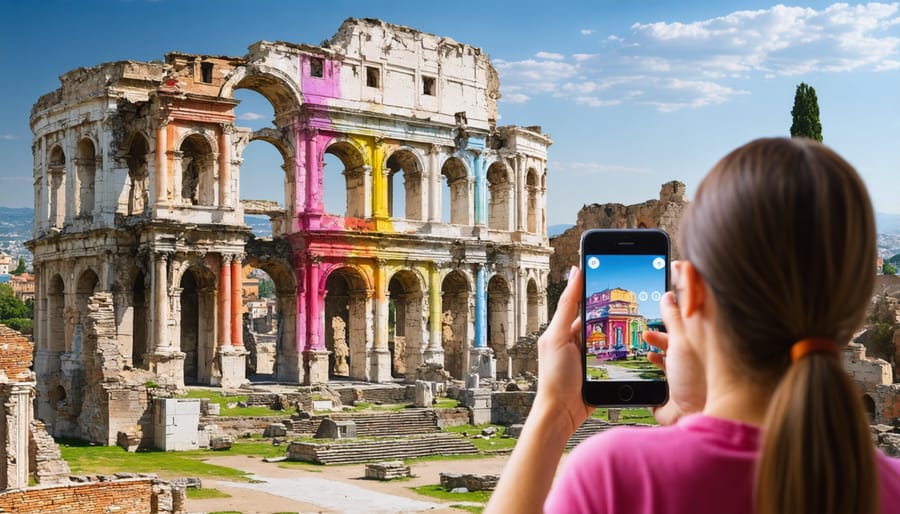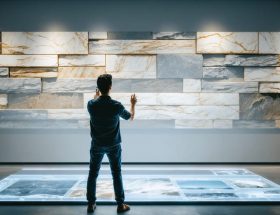Step back in time while stepping forward in technology. AR visualization technology is revolutionizing how we experience historical sites, transforming static ruins into vivid windows to the past. Instead of imagining ancient structures, visitors now witness them rebuilt before their eyes through their smartphone screens, complete with accurate architectural details and period-specific elements.
This digital renaissance in heritage tourism merges archaeological precision with cutting-edge innovation, allowing visitors to simultaneously occupy two time periods: the present physical space and its historical counterpart. From the Roman Forum to medieval castles, augmented reality overlays bring authentic reconstructions to life, backed by scholarly research and architectural documentation.
The technology not only enhances tourist experiences but serves as a powerful preservation tool, allowing conservators to digitally document delicate structures and create detailed records for future restoration work. This convergence of history and technology represents a fundamental shift in how we protect, study, and share our cultural heritage with future generations.
How AR Transforms Historical Stone Sites
Real-Time Stone Structure Visualization
Augmented reality technology has revolutionized how visitors experience ancient stone structures by seamlessly overlaying digital reconstructions onto existing ruins. Through sophisticated 3D modeling and texture mapping, AR applications can project historically accurate representations of original architectural features directly onto deteriorated or partially destroyed stone surfaces.
When visitors point their AR-enabled devices at stone ruins, they witness an immediate transformation as the technology renders missing elements, original paint colors, and intricate surface decorations. These visualizations are based on extensive archaeological research, historical documentation, and architectural analysis, ensuring accuracy while bringing ancient structures back to life.
The technology uses advanced computer vision algorithms to recognize specific stone features and maintain precise alignment even as visitors move around the site. High-resolution texture maps show authentic stone finishing techniques, while lighting engines simulate how sunlight would have interacted with the original surfaces throughout the day.
At sites like the Roman Forum, AR overlays reveal the vibrant painted surfaces that once adorned temple columns and friezes. Visitors can toggle between current and historical views, gaining a deeper understanding of how these magnificent structures appeared during their prime. The technology also highlights architectural details that have been lost to time, such as decorative capitals, cornices, and relief carvings.
Conservation teams benefit from this technology as well, using AR visualizations to plan restoration work and document changes in stone conditions over time. Educational institutions utilize these tools to teach architectural history, allowing students to study construction techniques and decorative elements in their original context.
This immersive approach to historical visualization helps bridge the gap between present-day ruins and their former glory, creating a more engaging and educational experience for visitors while supporting preservation efforts.
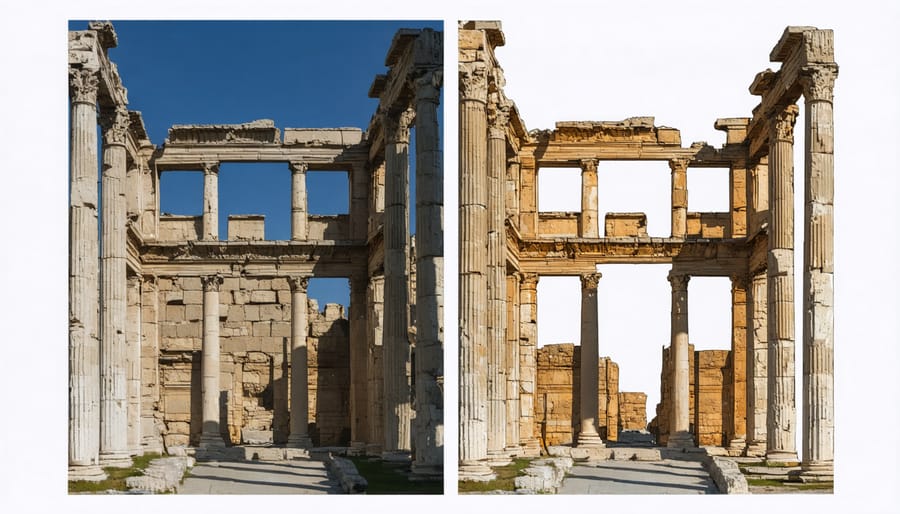
Interactive Historical Information
Augmented reality technology transforms historical sites into interactive learning environments by overlaying detailed information about construction methods, stone types, and architectural significance. Visitors can point their mobile devices at specific features to instantly access comprehensive data about the materials and techniques used centuries ago. This technology particularly shines when exploring ancient natural stone preservation techniques and architectural elements.
When viewing a Roman column through an AR interface, users can see detailed breakdowns of its limestone composition, construction timeline, and even animations demonstrating how ancient builders assembled these massive structures. The technology identifies different stone types used throughout historical buildings, highlighting variations in granite, marble, and sandstone while explaining why specific materials were chosen for different architectural elements.
AR applications can also reveal hidden architectural features, such as original stone cutting marks, mason’s marks, and construction joints that might otherwise go unnoticed. By providing this layered information, visitors gain a deeper understanding of historical building practices and the evolution of stone construction techniques.
The interactive experience extends to preservation efforts, showing before-and-after comparisons of restoration work and highlighting areas requiring conservation. This helps visitors understand the ongoing challenges of maintaining historical structures and the importance of modern preservation methods. Educational institutions and heritage sites increasingly rely on this technology to make historical information more engaging and accessible to diverse audiences, from casual tourists to architecture students and preservation specialists.
Notable AR-Enhanced Stone Monuments
Ancient Roman Marble Structures
Augmented reality has revolutionized how visitors experience ancient Roman marble structures, bringing these magnificent ruins back to life through digital reconstruction. The Colosseum in Rome stands as a prime example, where AR applications allow tourists to witness the grandeur of its original marble facades and intricate architectural details. Through their mobile devices, visitors can see the complete structure as it appeared in 80 AD, complete with its decorative marble columns and elaborate statuary.
At the Roman Forum, AR technology reconstructs the Temple of Venus and Roma, showcasing how its gleaming white marble columns and ornate cornices once dominated the ancient cityscape. Visitors can toggle between current and historical views, gaining a deeper understanding of how time and elements have affected these marble structures.
The Baths of Caracalla demonstrate another successful implementation of AR technology in archaeological sites. Here, digital overlays reveal the complex system of marble-clad pools, steam rooms, and exercise areas that once served thousands of Roman citizens daily. The AR experience highlights the sophisticated use of different marble varieties, from the local Carrara to imported stones from across the empire.
These AR applications not only enhance visitor engagement but also serve as valuable tools for conservation teams. By comparing historical records with current conditions, preservationists can better track changes in marble surfaces and plan appropriate restoration measures. The technology has proven particularly useful in documenting weathering patterns and identifying areas requiring immediate attention.
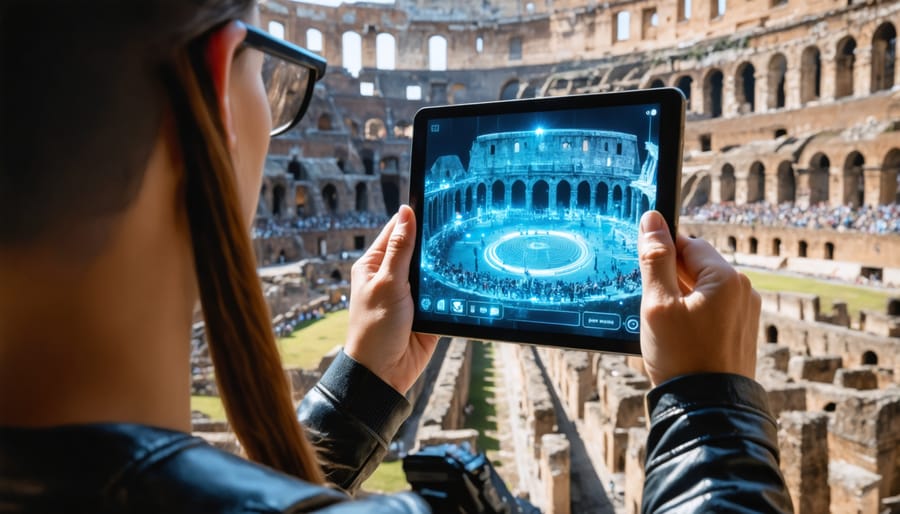
Medieval Stone Castles
Augmented reality has revolutionized how visitors experience medieval stone castles, bringing centuries-old ruins back to their former magnificence. By simply pointing their smartphones or tablets at existing structures, visitors can witness these fortifications transform before their eyes, complete with historically accurate reconstructions of walls, towers, and battlements.
Notable examples include Scotland’s Caerlaverock Castle, where AR technology overlays the complete triple-sided fortress structure onto today’s remains, demonstrating historical stone construction methods and defensive features. At Wales’ Raglan Castle, visitors can watch the grand Tudor-era palace materialize around them, complete with period-accurate furnishings and architectural details.
The technology doesn’t just recreate physical structures; it also simulates historical activities and daily castle life. Users can witness virtual representations of medieval builders at work, observe defensive operations at the battlements, or explore fully furnished great halls and living quarters as they would have appeared centuries ago.
These AR applications often include interactive elements that explain architectural features, construction techniques, and historical events. Educational institutions particularly value this technology for its ability to make historical learning more engaging and memorable, while preservation specialists use it to better understand and document original construction details for restoration work.
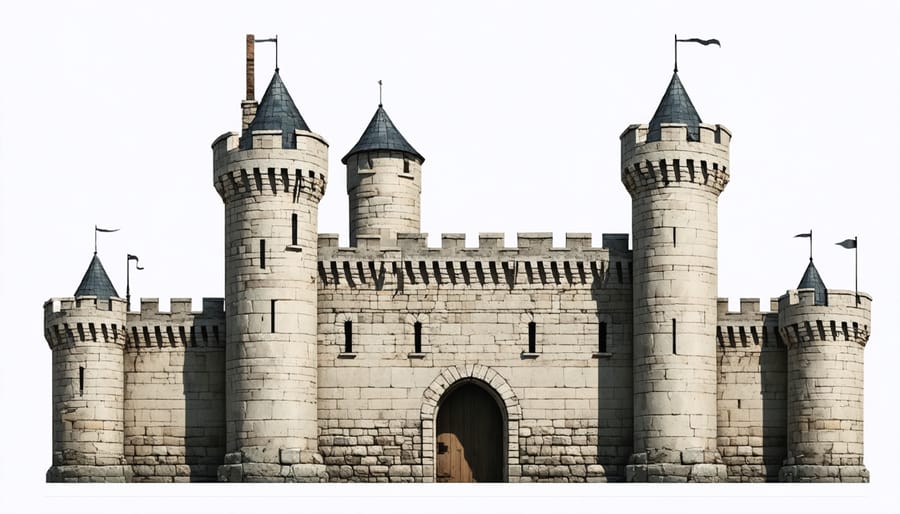
Conservation Benefits of AR Technology
Augmented reality technology offers a revolutionary approach to stone structure preservation while significantly enhancing visitor engagement at historical sites. By creating digital overlays instead of physical interpretive materials, AR reduces the need for invasive installations that could potentially damage ancient stonework. This non-contact solution allows visitors to experience detailed historical information without compromising the structural integrity of the site.
The technology proves particularly valuable in areas where traditional preservation methods might be too risky or invasive. For instance, at the Roman Baths in Bath, England, AR applications enable visitors to visualize the original architecture without any physical reconstruction, protecting the authentic stone remains while offering an immersive educational experience.
AR also helps monitor and document wear patterns on stone surfaces by creating precise digital records over time. Conservation teams can use these detailed mappings to identify areas requiring immediate attention and develop targeted preservation strategies. This proactive approach significantly reduces the risk of irreversible damage to historical structures.
Furthermore, AR applications can demonstrate the effects of environmental factors on stone monuments, raising awareness about conservation challenges. Visitors can witness simulated degradation processes and understand the importance of preservation efforts, fostering a deeper appreciation for these historical treasures.
The technology also allows sites to remain accessible during conservation work. While physical areas undergo restoration, visitors can still experience these spaces through AR viewpoints, maintaining tourism revenue that often funds preservation efforts. This balanced approach ensures both the protection of historical structures and continued public engagement with cultural heritage.
By combining cutting-edge technology with traditional conservation methods, AR creates a sustainable model for historical site management that preserves ancient stonework for future generations while enriching the modern visitor experience.
The integration of augmented reality at historical stone sites represents a transformative approach to preservation and visitor engagement. By overlaying digital information onto physical structures, AR technology has revolutionized how we experience and understand our architectural heritage. This technological advancement not only enhances visitor experiences through interactive storytelling and immersive reconstructions but also aids conservators in monitoring and documenting stone deterioration with unprecedented precision.
Looking ahead, emerging developments in AR technology promise even more sophisticated applications. From AI-powered damage prediction models to real-time collaborative restoration planning, the future of historical site preservation appears increasingly digital. As AR technology becomes more accessible and refined, we can expect to see wider adoption across heritage sites worldwide, creating a perfect blend of historical authenticity and modern innovation that benefits both preservation efforts and public education.

